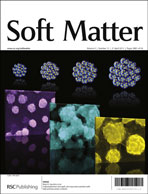Switching preorganization and thermoresponsive behavior of a water-soluble polymer via light-tunable hydrogen bonding
Abstract
We report a general approach that can switch preorganization and thermoresponsive behaviour of a water-soluble polymer via light-tuned hydrogen bonding (H-bonding) “dimerization” or “polymerisation”. To this end, well-defined copolymers of 2-hydroxy-3-(4-hydroxyiminomethyl)phenoxypropyl methacrylate with oligo(ethylene glycol) methacrylate (OEGMA) were synthesized via RAFT copolymerisation of 3-(4-formylphenoxy)-2-hydroxypropyl methacrylate with OEGMA under visible light irradiation at 25 °C and fully converting the aldehyde groups into the targeted oxime groups. Photoisomerization and stability of these oxime groups, and the effect of oxime configurations on preorganization and thermoresponsive behaviour were studied using dynamic light scattering and temperature-variable 1H NMR. The results demonstrated that photoisomerization of E-oximes equilibrated at 76% Z-type formation. These oxime groups were stable against heating at 80 °C in water for 8 h. Moreover, the self-restrained H-bonding “dimerization” of E-oximes led to the small-sized micelles with negligible hysteresis, while the extensible H-bonding “polymerisation” of Z-type ones led to the enlarged micelles with remarkable hysteresis.


 Please wait while we load your content...
Please wait while we load your content...